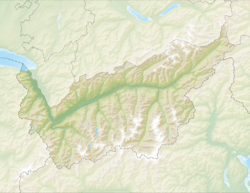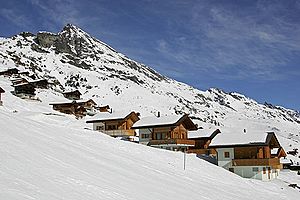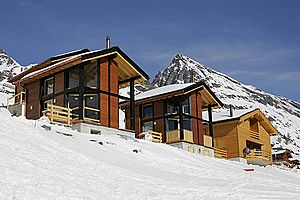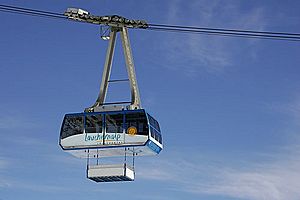Wiler facts for kids
Quick facts for kids
Wiler (Lötschen)
|
||
|---|---|---|
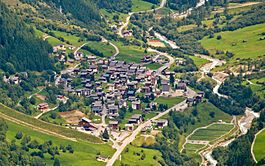 |
||
|
||
| Country | Switzerland | |
| Canton | Valais | |
| District | Raron | |
| Area | ||
| • Total | 14.86 km2 (5.74 sq mi) | |
| Elevation | 1,421 m (4,662 ft) | |
| Population
(Dec 2020 )
|
||
| • Total | 565 | |
| • Density | 38.02/km2 (98.48/sq mi) | |
| Postal code |
3918
|
|
| Surrounded by | Blatten (Lötschen), Kandersteg (BE), Kippel, Niedergesteln, Raron | |
Wiler (Lötschen) is a small town, also called a municipality, in Switzerland. It is located in the Valais canton, which is like a state, and is part of the Raron district. Wiler is known for its beautiful mountain views and traditional Swiss feel.
Contents
Exploring Wiler's Land
Wiler covers an area of about 14.7 square kilometers (5.7 square miles). A big part of this land is covered by forests, about 23.2%. Another 19.3% is used for farming, like pastures for animals.
About 2.5% of Wiler's land has buildings and roads. A small part, 1%, is made up of rivers or lakes. The largest part, 54.2%, is unproductive land. This means it's too rocky or covered by glaciers to grow much.
Wiler's Coat of Arms
The coat of arms for Wiler is a special design that represents the town. It shows four red rose-like flowers, called Cynorrhodon Flowers. These flowers are joined together and surrounded by a green garland. At the bottom, there are green hills. This design is called a blazon.
Who Lives in Wiler?
Wiler has a population of about 538 people. Over the past ten years, the number of people living here has grown by about 9.3%. Most people in Wiler speak German, which is 98.2% of the population. A small number of people also speak Serbo-Croatian or Danish.
Most of the people living in Wiler were born there, about 72.7%. Others were born in the same canton or elsewhere in Switzerland. About 5.1% of the people living in Wiler are from other countries.
When we look at age groups, about 21.5% of the population are children and teenagers (0-19 years old). Adults (20-64 years old) make up 65%, and seniors (over 64 years old) are 13.5%.
In Wiler, there are about 175 households, with an average of 2.8 people living in each. Some households have only one person, while others have five or more. Many apartments in Wiler are used seasonally, meaning people live there only at certain times of the year, like for holidays.
The chart below shows how Wiler's population has changed over many years:

Wiler's Economy and Jobs
In 2010, Wiler had a very low unemployment rate of 1.3%. This means most people who wanted to work had a job.
Jobs in Wiler are divided into three main types:
- Primary sector: This includes jobs like farming and forestry. About 54 people work in this area.
- Secondary sector: These jobs involve making things, like in factories or construction. About 28 people work here.
- Tertiary sector: This is the largest sector, with 113 people working in services. This includes jobs in hotels, restaurants, shops, transportation, education, and healthcare.
Many people who live in Wiler travel to other towns for work. About 23.1% use public transportation, like buses, and 42.4% drive their own cars.
Getting Around Wiler
Wiler is located on the main road that goes through the Lötschental valley. This road connects Wiler to other towns like Steg and Goppenstein. The road ends at a place called Fafleralp.
There is a bus service, called PostAuto, that runs along this road. It connects Wiler to the Goppenstein railway station, making it easy for people to travel by train.
Religion in Wiler
Most people in Wiler are Roman Catholic, making up about 96.7% of the population. A smaller number, about 2.7%, belong to the Swiss Reformed Church. Very few people do not belong to any church.
Education in Wiler
In Wiler, many adults have completed their education. About 44.3% have finished upper secondary education, which is like high school. About 5.3% have gone on to higher education, either at a university or a specialized college called a Fachhochschule.
Some students from Wiler go to schools in other towns. Also, a few students from other municipalities come to Wiler for school.
See also
 In Spanish: Wiler (Lötschen) para niños
In Spanish: Wiler (Lötschen) para niños




